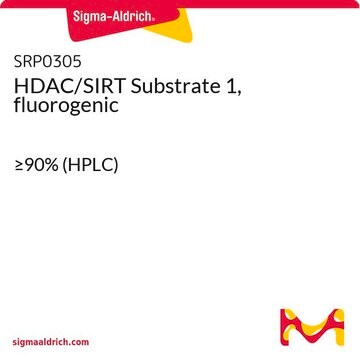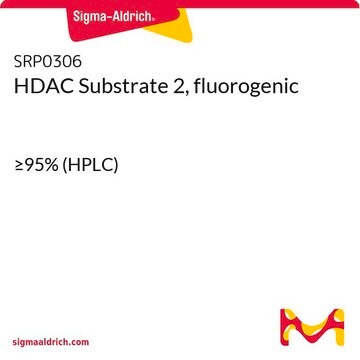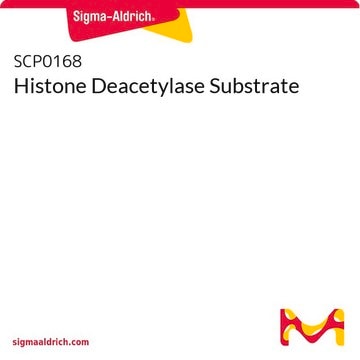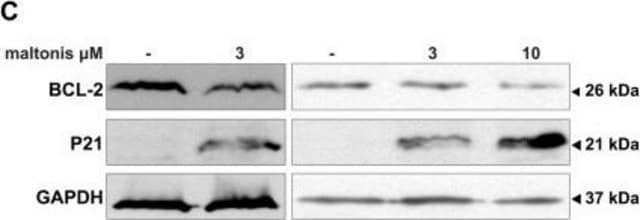17-320
Histone Deacetylase Assay Kit (HDAC)
Se connecterpour consulter vos tarifs contractuels et ceux de votre entreprise/organisme
About This Item
Code UNSPSC :
12161503
eCl@ss :
32161000
Nomenclature NACRES :
NA.84
Produits recommandés
Description générale
FUNCTION: SwissProt: Q9UQL6 # Responsible for the deacetylation of lysine residues on the N-terminal part of the core histones (H2A, H2B, H3 and H4). Histone deacetylation gives a tag for epigenetic repression and plays an important role in transcriptional regulation, cell cycle progression and developmental events. Histone deacetylases act via the formation of large multiprotein complexes. Involved in muscle maturation by repressing transcription of myocyte enhancer MEF2C. During muscle differentiation, it shuttles into the cytoplasm, allowing the expression of myocyte enhancer factors.
SIZE: 1122 amino acids; 121992 Da
SUBUNIT: Interacts with BCOR, HDAC7, HDAC9, CTBP1, MEF2C, NCOR2, NRIP1, PHB2 and a 14-3-3 chaperone protein. Interacts with JARID1B.
SUBCELLULAR LOCATION: Nucleus. Cytoplasm. Note=Shuttles between the nucleus and the cytoplasm. In muscle cells, it shuttles into the cytoplasm during myocyte differentiation. The export to cytoplasm depends on the interaction with a 14-3-3 chaperone protein and is due to its phosphorylation at Ser-259 and Ser-498 by CaMK.TISSUE SPECIFICITY: Ubiquitous.DOMAIN:SwissProt: Q9UQL6 The nuclear export sequence mediates the shuttling between the nucleus and the cytoplasm (By similarity).
PTM: Phosphorylated by CaMK at Ser-259 and Ser-498. The phosphorylation is required for the export to the cytoplasm. & Ubiquitinated. Polyubiquitination however does not lead to its degradation.
SIMILARITY: Belongs to the histone deacetylase family. Type 2 subfamily.
SIZE: 1122 amino acids; 121992 Da
SUBUNIT: Interacts with BCOR, HDAC7, HDAC9, CTBP1, MEF2C, NCOR2, NRIP1, PHB2 and a 14-3-3 chaperone protein. Interacts with JARID1B.
SUBCELLULAR LOCATION: Nucleus. Cytoplasm. Note=Shuttles between the nucleus and the cytoplasm. In muscle cells, it shuttles into the cytoplasm during myocyte differentiation. The export to cytoplasm depends on the interaction with a 14-3-3 chaperone protein and is due to its phosphorylation at Ser-259 and Ser-498 by CaMK.TISSUE SPECIFICITY: Ubiquitous.DOMAIN:SwissProt: Q9UQL6 The nuclear export sequence mediates the shuttling between the nucleus and the cytoplasm (By similarity).
PTM: Phosphorylated by CaMK at Ser-259 and Ser-498. The phosphorylation is required for the export to the cytoplasm. & Ubiquitinated. Polyubiquitination however does not lead to its degradation.
SIMILARITY: Belongs to the histone deacetylase family. Type 2 subfamily.
Conditionnement
Kit capacity: 100 assays
Composants
HeLa NuCLEAR™ Extract (Cat.# 12-309) Histone H4 Peptide, biotin conjugate, residues 2-24 (Cat.# 12-372) HAT Assay Buffer, 5X (Cat.# 20-148) Sodium Butyrate (Cat.# 19-137) 5X HDAC Assay Buffer Streptavidin Agarose PCAF active
Qualité
Routinely evaluated with two experiments, The dependence of HDAC activity on HeLa Nuclear Extract and the inhibition of HDAC Activity by Sodium Butyrate.
In the first experiment, HeLa nuclear extract was incubated at room temperature with [3H]-acetyl-Histone H4 peptide. Released [3H]-acetate was measured using a scintillation counter.
In the second experiment, [3H]-acetyl-Histone H4 peptide was incubated with HeLa nuclear extract in the presence or absence of Sodium Butyrate. Sodium Butyrate inhibited release of [3H]-acetate by ~92%.
In the first experiment, HeLa nuclear extract was incubated at room temperature with [3H]-acetyl-Histone H4 peptide. Released [3H]-acetate was measured using a scintillation counter.
In the second experiment, [3H]-acetyl-Histone H4 peptide was incubated with HeLa nuclear extract in the presence or absence of Sodium Butyrate. Sodium Butyrate inhibited release of [3H]-acetate by ~92%.
Informations légales
NuCLEAR is a trademark of Sigma-Aldrich Co. LLC
Clause de non-responsabilité
Unless otherwise stated in our catalog or other company documentation accompanying the product(s), our products are intended for research use only and are not to be used for any other purpose, which includes but is not limited to, unauthorized commercial uses, in vitro diagnostic uses, ex vivo or in vivo therapeutic uses or any type of consumption or application to humans or animals.
Certificats d'analyse (COA)
Recherchez un Certificats d'analyse (COA) en saisissant le numéro de lot du produit. Les numéros de lot figurent sur l'étiquette du produit après les mots "Lot" ou "Batch".
Déjà en possession de ce produit ?
Retrouvez la documentation relative aux produits que vous avez récemment achetés dans la Bibliothèque de documents.
Notre équipe de scientifiques dispose d'une expérience dans tous les secteurs de la recherche, notamment en sciences de la vie, science des matériaux, synthèse chimique, chromatographie, analyse et dans de nombreux autres domaines..
Contacter notre Service technique








